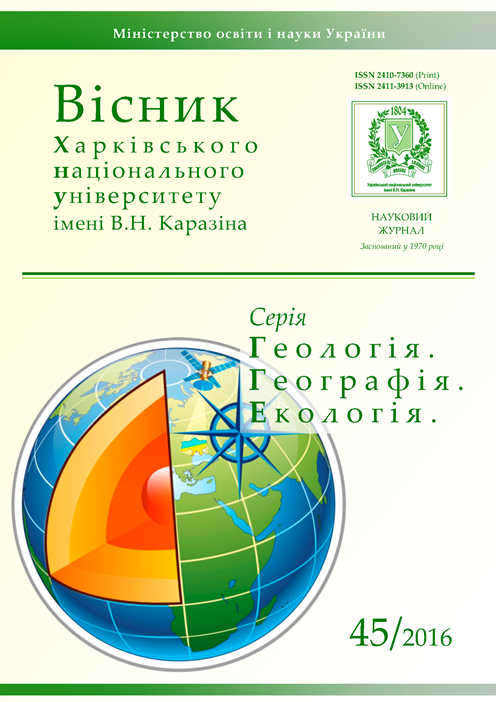Про особливості суфозії карбонатних порід
Анотація
Розглянуто особливості суфозії карбонатних порід. На прикладі відкладень мергельно-крейдяної товщі верхньої крейди південного крила Святогірської брахіантикліналі продемонстровано, що суфозія є наслідком фізичної (механічної) діяльності інфільтраційних вод з формуванням поверхневого і підземного твердого стоку.
З’ясовано, що суфозійні процеси у мергельно-крейдяній товщі не лише призводять до денудації карбонатних порід, а й збільшують інтенсивність водообміну в них. Експериментально доведено, що розвиток суфозії обумовлюється динамікою інфільтраційних вод у різні сезони року, у зв’язку з чим найінтенсивніший розвиток цього процесу відбувається навесні та восени і залежить від характеру рельєфу як одного з основних природних чинників, що регулюють спрямованість суфозії.
Суфозійні процеси розвиваються на фоні сучасної тектонічної активізації Петрівсько-Кремінського розламу, з якою пов’язана не тільки дезінтеграція карбонатних порід у гірському масиві, а й сучасне здіймання території. Висхідний розвиток рельєфу супроводжується зростанням потенціалу денудаційних процесів і, відповідно, збільшенням їх впливу на земну поверхню.
На етапі розвитку суфозії, що характеризується подрібненням карбонатних часток до розмірів суспензії, у системі «порода-вода» спостерігається перехід фізичних (суфозійних) процесів у хімічні (карстові), що повністю відповідає одному з основних законів природи про перехід кількісних змін у якісні.
Завантаження
Посилання
2. Babynets, A. E. (1961). Podzemnie vodi yuho-zapada Russkoy platform. Kyev, Izd-vo AN USSR, 378.
3. Veryhyn, N. N., Sherzhukov, B. S. (1969). Dyffuzyya y massoobmen pry fyl'tratsyy zhydkostey v porystikh sredakh. V kn.: Razvytye yssledovanyy po teoryy fyl'tratsyy v SSSR (1917-1967). M., Nauka, 237-313.
4. Shestopalov, V. M., Sytnykov, A. B., Lyal'ko, V. Y. i dr. (1988). Vodoobmen v hydroheolohycheskykh strukturakh Ukrayni. Metodi yzuchenyya vodoobmena. Izd. IHN AN USSR, Kyev, Nauk. dumka, 272.
5. Hydroheolohyya SSSR. T. VI, Donbass (1971). M., Nedra. 480.
6. Hirnychyy entsyklopedychnyy slovnyk, t. 2. (2002). Za red. V.S. Bilets'koho. Donets'k, Skhidnyy vydavnychyy dim, 632.
7. Demchyshyn, M. H., Anats'kyy, O. M. (2008). Inzhenerno-heolohichni umovy v dolynakh rivnynnykh rik. U zb. «Budivel'ni konstruktsiyi». K., NDIBK, Kn. 1, 71, 156-164.
8. Emel'yanova, E. H. (1972). Osnovnie zakonomernosty opolznevikh protsessov. M., Nedra, 310.
9. Kosmachev, V. H. (1975). Drevnyy karst v Yzyumskom rayone. Putevodytel' ekskursyy III s`ezda Heohrafycheskoho obshchestva USSR. Kh., Oblpolyhrafyzdat, 55-58.
10. Lomtadze, V. D. (1978). Ynzhenernaya heolohyya. Spetsyal'naya ynzhenernaya heolohyya. L., Nedra, 496.
11. Lopatyn, H. V. (1950). Erozyya y stok nanosov. Pryroda, 7, 19-28.
12. Luhovoy, V. P., Ostapenko, Yu. S., Zhuryn, S. M., Sukhov, V. V. (1999). Osobennosty razvytyya suffozyonnikh yavlenyy na terrytoryy s yntensyvnoy tekhnohennoy nahruzkoy. Visnyk KhNU imeni V. N. Karazina, seriya «Heolohiya – Heohrafiya – Ekolohiya», 455, 65-72.
13. Lushchyk A. V., Morozov V. Y., Myleshyn V. P. (1981). Podzemnie vodi karstovikh platformennikh oblastey yuha Ukrayni. K., Nauk. Dumka, 200.
14. Lushchyk A. V., Lysychenko H. V., Yakovlev E. O. (1988). Formyrovanye rezhyma podzemnikh vod v rayonakh razvytyya aktyvnikh heodynamycheskykh protsessov. K., Naukova dumka, 164.
15. Pynneker E. V., Pysarskyy B. Y., Shvartsev S. L. y dr. (1982). Osnovi hydroheolohyy. Heolohycheskaya deyatel'nost' y ystoryya vodi v zemnikh nedrakh. Novosybyrsk, Nauka, 239.
16. Pavlov, A. N. Heolohycheskyy kruhovorot vodi na Zemle(1974). M., Misl', 448.
17. Sukhov, V. V. (2009). Typyzatsyya slozhnikh ynzhenerno-heolohycheskykh uslovyy y ystochnykov heolohycheskoy opasnosty dlya pamyatnykov ystoryy y arkhytekturi. Visnyk KhNU imeni V. N. Karazina, seriya «Heolohiya – Heohrafiya – Ekolohiya», 864, 89-93.
18. Sukhov, V. V. (2012). Ynzhenerno-heolohycheskye y hydroheolohycheskye faktori vlyyanyya na stabyl'nost' ystoryko-arkhytekturnikh pamyatnykov. Visnyk KhNU imeni V. N. Karazina, seriya «Heolohiya – Heohrafiya – Ekolohiya», 997, 73-76.
19. Suyarko, V. H., Sukhov, V. V. (2015). Kontseptual'na synerhetychna heoloho-hidroheolohichna model' rozvytku sufoziyi ta karstu u karbonatnykh porodakh na terytoriyi Svyatohirs'koho monastyrya. Visnyk KhNU imeni V. N. Karazina, seriya «Heolohiya. Heohrafiya. Ekolohiya», 1157, 63-68.
20. Chaban M. O. (1981). Kryteryy natural'noho podobyya v hydroheolohyy. Vodnie resursi, 1, 64-76.
21. Shestopalov, V. M., Klymchuk, A. B., Tokarev, S. V., Amelychev, H. N. (2009). Otsenka uyazvymosty podzemnikh vod rayonov otkritoho karsta (na prymere massyva Ay-Petry, Krim). Speleolohyya y karstolohyya, 2, 11-29.
22. Enhel'hart, V. (1968). Porovie vodnie rastvori y katahenez porod. V kn. Dyahenez y katahenez osadochnikh obra-zovanyy. M., Myr, 443-458.





